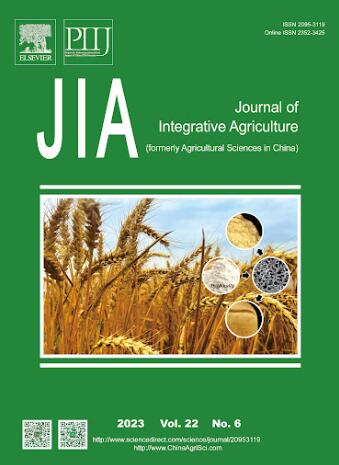Host-induced gene silencing of the Verticillium dahliae thiamine transporter protein gene (VdThit) confers resistance to Verticillium wilt in cotton
IF 4.4
1区 农林科学
Q1 AGRICULTURE, MULTIDISCIPLINARY
引用次数: 0
Abstract
Verticillium wilt (VW), induced by the soil-borne fungus (), poses a substantial threat to a diverse array of plant species. Employing molecular breeding technology for the development of cotton varieties with heightened resistance to VW stands out as one of the most efficacious protective measures. In this investigation, we successfully generated two stable transgenic lines of cotton ( L.) -RNAi-1 and -RNAi-2 using host-induced gene silencing (HIGS) technology to introduce double-stranded RNA (dsRNA) targeting the thiamine transporter protein gene (). Southern blot analysis confirmed the presence of a single-copy insertion in both lines. Microscopic examination disclosed a marked reduction in the colonization and spread of - in the roots of -RNAi cotton compared to wild type (WT). Correspondingly, the disease index and fungal biomass of -RNAi-1/2 exhibited a significant decrease. Real-time quantitative PCR (qRT-PCR) analysis demonstrated a substantial inhibition of expression following prolonged inoculation of -RNAi cotton. Small RNA sequencing (sRNA-Seq) analysis further revealed the generation of a substantial number of -specific siRNAs in the -RNAi transgenic lines. Additionally, the silencing of by siVdThit produced by -RNAi-1/2 resulted in the elevated expression of multiple genes involved in the thiamine biosynthesis pathway in . In field conditions, -RNAi transgenic cotton exhibited significantly enhanced disease resistance and yield compared with WT. In summary, our findings underscore the efficacy of HIGS targeting in restraining the infection and spread of in cotton, thereby potentially expediting the development of cotton breeding as a promising strategy.宿主诱导的大丽轮枝菌硫胺素转运蛋白基因(VdThit)沉默可使棉花产生对轮枝菌枯萎病的抗性
由土传真菌()诱发的枯萎病(VW)对多种植物物种构成严重威胁。利用分子育种技术培育对轮纹病具有更强抗性的棉花品种是最有效的保护措施之一。在这项研究中,我们利用宿主诱导基因沉默(HIGS)技术,引入以硫胺素转运蛋白基因()为靶标的双链 RNA(dsRNA),成功培育出两个稳定的转基因棉花品系-RNAi-1 和 -RNAi-2。Southern 印迹分析证实这两个品系中都存在单拷贝插入。显微镜检查显示,与野生型(WT)相比,-RNAi 棉花根部的-定殖和扩散明显减少。相应地,-RNAi-1/2 的病害指数和真菌生物量也显著下降。实时定量 PCR(qRT-PCR)分析表明,在长时间接种 -RNAi 棉花后,其表达受到了极大的抑制。小 RNA 测序(sRNA-Seq)分析进一步显示,在 -RNAi 转基因品系中产生了大量 - 特异性 siRNA。此外,-RNAi-1/2 产生的 siVdThit 沉默还导致参与硫胺素生物合成途径的多个基因表达量升高。 在田间条件下,与 WT 相比,-RNAi 转基因棉花的抗病性和产量均显著提高。总之,我们的研究结果强调了以 HIGS 为靶标抑制棉花感染和传播的功效,从而有可能加快棉花育种的发展,成为一种前景广阔的策略。
本文章由计算机程序翻译,如有差异,请以英文原文为准。
求助全文
约1分钟内获得全文
求助全文
来源期刊

Journal of Integrative Agriculture
AGRICULTURE, MULTIDISCIPLINARY-
CiteScore
7.90
自引率
4.20%
发文量
4817
审稿时长
3-6 weeks
期刊介绍:
Journal of Integrative Agriculture publishes manuscripts in the categories of Commentary, Review, Research Article, Letter and Short Communication, focusing on the core subjects: Crop Genetics & Breeding, Germplasm Resources, Physiology, Biochemistry, Cultivation, Tillage, Plant Protection, Animal Science, Veterinary Science, Soil and Fertilization, Irrigation, Plant Nutrition, Agro-Environment & Ecology, Bio-material and Bio-energy, Food Science, Agricultural Economics and Management, Agricultural Information Science.
 求助内容:
求助内容: 应助结果提醒方式:
应助结果提醒方式:


